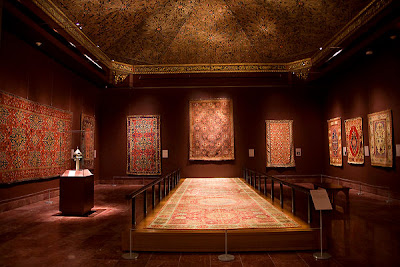The New York Times (28 October 2011) reports on a new exhibition at the New York Metropolitan Museum of Art opening soon which displays some of the world’s most precious Islamic artifacts:
"Over the past decade, many Americans have based their thoughts and feelings about Islam in large part on a single place: the blasted patch of ground where the World Trade Center once stood. But a rival space has slowly and silently taken shape over those same years, about six miles to the north. It is a vast, palacelike suite of rooms on the second floor of the Metropolitan Museum of Art, where some of the world’s most precious Islamic artifacts sit sequestered behind locked doors.
When the Met’s Islamic galleries first opened in 1975, they were presented as a cultural monolith, where nations and cultures were subsumed under one broad banner, as if Islam were another planet. Haidar and her colleagues have tried to emphasize the diversity of Islamic cultures across time and space. One result of that altered emphasis was the gallery’s new name. The “Islamic Wing” is gone, replaced by the “Galleries for the Art of the Arab Lands, Turkey, Iran, Central Asia and Later South Asia.” It is a mouthful, but it makes a point.
“Not one world, but many; not another world, but our own,” Haidar said, repeating the mantra that has guided her thinking about the new collection over the years.
The collection is full of deliciously heterodox crossovers, like an image of the blue-skinned Hindu god Krishna that was painted for Akbar, the Muslim ruler of north and central India, in the late 16th century. There are Persian bowls alongside the Chinese models that inspired them. There is Muslim art from Spain and south Italy.
Last month, Haidar got a taste of public reaction when dignitaries in town for the United Nations General Assembly asked to see the new galleries. One of them was Benjamin Netanyahu, the Israeli prime minister, who was a model guest, admiring the art and chuckling at a wooden panel from Tikrit, the birthplace of Saddam Hussein. But he stopped short when Haidar showed him a 10th-century Muslim prayer mat that was found on the shores of Lake Tiberias. The date suggested a very early Muslim presence in what is now Israel. Netanyahu asked if it was really that old, Haidar recalled, and she assured him that the carpet had been scientifically dated. But he kept staring at it quizzically. “ ‘I don’t know,’ he finally said, ‘it just doesn’t look that old to me.’ ”
You can read the full article here.
You can learn more at the Museum website here.
Subscribe to:
Post Comments (Atom)



No comments:
Post a Comment